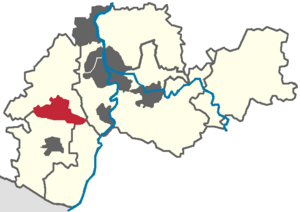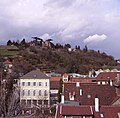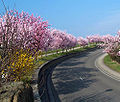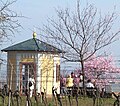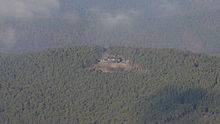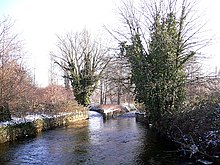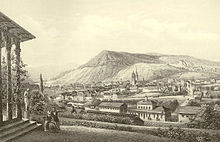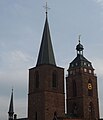Neustadt an der Weinstrasse
| coat of arms | Germany map | |
|---|---|---|

|
Coordinates: 49 ° 21 ' N , 8 ° 9' E |
|
| Basic data | ||
| State : | Rhineland-Palatinate | |
| Height : | 136 m above sea level NHN | |
| Area : | 117.1 km 2 | |
| Residents: | 53,264 (Dec. 31, 2019) | |
| Population density : | 455 inhabitants per km 2 | |
| Postcodes : | 67433, 67434, 67435 | |
| Primaries : | 06321, 06327 | |
| License plate : | NW | |
| Community key : | 07 3 16 000 | |
| NUTS : | DEB36 | |
| City structure: | Core city and nine districts | |
City administration address : |
Marktplatz 1 67433 Neustadt an der Weinstrasse |
|
| Website : | ||
| Lord Mayor : | Marc Weigel (FWG) | |
| Location of Neustadt an der Weinstrasse in Rhineland-Palatinate | ||
Neustadt an der Weinstrasse , until 1936 and from 1945 to 1950 Neustadt an der Haardt , is an independent city in Rhineland-Palatinate and part of the Rhine-Neckar metropolitan region . It is one of the ten largest cities in the state. The city in the Palatinate on the German Wine Route is one of the centers of German viticulture and annually organizes the German Wine Festival , at which the German Wine Queen is usually chosen. Neustadt is also known for the Hambacher Schloss , located in the urban area , the scene of the Hambach Festival of the German democracy movement in 1832.
Since Neustadt is a common place name, various abbreviations are used in the literature for the current and the older name affix. The most common occurrences are: “/ Wstr.”, “A. d. W. "or" a. d. Wstr. "And" a. d. H. "or" a. d. Hdt. "
The inhabitants of Neustadt an der Weinstrasse are called Neustadter ; this is pronounced “Naischdadter” in the local dialect .
geography
location
The core city is 136 m above sea level. NHN in the west of the Rhine-Neckar metropolitan region between the Haardt , the eastern edge of the Palatinate Forest , and the western edge of the Upper Rhine Plain in the middle of the Palatinate's largest wine-growing region, which is ten kilometers wide and 85 kilometers long . The west of the district clearly protrudes into the central Palatinate Forest . There are several valleys such as the Finstertal , the Heidenbrunnertal , the Hellertal , the Kaltenbrunn Valley . The southeast of the urban area is in the middle of the Gäu .
The west-east extension of the urban area including the incorporated districts is 22.5 kilometers, the north-south extension 9.5 kilometers. The highest point is in the southwest at 614 m at the Hohe-Loog-Haus in the Haardt and the lowest at 108 m in the southeastern district of Geinsheim.
Neighboring municipalities are clockwise and starting in the north Ruppertsberg , Meckenheim , Haßloch , Hanhofen , Harthausen , Gommersheim , Böbingen , Altdorf , Venningen , Kirrweiler , Maikammer , Kirrweiler (exclave), Esthal , Lambrecht , Lindenberg and Deidesheim .
City structure
Core city and district
Over time, some of the surrounding settlements, hamlets and farmsteads have grown together with the city center in such a way that their former boundaries to the city have been blurred, such as Branchweiler in the southeast, the Hambacher Höhe in the southwest and the Afrikaviertel (so called because of the streets that were named after Africa researchers are named) and the Schöntal in the west. Today they are considered to be urban districts without special privileges, so they do not legally count as incorporated districts.
The most famous district is Winzingen . Winzingen was first mentioned in 774 and is therefore much older than the "New City" founded in the early 13th century. It was a winegrowing village that lay on the Speyerbach below, i.e. east of the new foundation. In 1892 it was incorporated into what was then Neustadt an der Haardt . In the meantime, the city has grown further east beyond Winzingen.
Including all incorporated districts, the area of Neustadt extends over 11,713.5 hectares. Of this, 5020 hectares are forest, 2216 hectares are vineyards, 2300 hectares are used for other agricultural purposes, 1607 hectares are built-up areas and 50 hectares are industrial and commercial areas.
Districts
In 1969 the previously independent municipalities of Diedesfeld , Geinsheim , Gimmeldingen , Haardt , Hambach , Königsbach , Lachen-Speyerdorf and Mußbach and in 1974 Duttweiler were incorporated into Neustadt, which are between one and ten kilometers from the city center. They are districts, are legally called local districts and have a local councilor and a local council .
Surveys
There are numerous mountains of the Palatinate Forest in the west of the city boundary. The highest point is 618.7 m above sea level. NHN measuring Hohe Loog in the south-west, whose south-south-east spur is 540.8 m above sea level. NHN represents high summer side . In the immediate catchment area there are other peaks such as the Taubenkopf ( 603.8 m above sea level ), the Zwergberg ( 589.3 m above sea level ), the Rittersberg ( 531.8 m above sea level ), the Sternberg ( 511.3 m above sea level ), the Sommerberg ( 501.9 m above sea level ) and in the very east of the Nollenkopf ( 490.3 m above sea level ), the Nollensattel ( 320.4 m above sea level ), the Kastanienberg , the Häuselberg ( 319.8 m above sea level ), the Heidelberg ( 313.4 m above sea level ) and the Schlossberg von Hambach ( 279.2 m above sea level ).
In the north-west it extends 554 m above sea level. NHN high massif of the wine region with its 319 m above sea level. NHN high east runner Nebelberg , its south runner Wolfsberg ( 490.7 m above sea level ) and its west runner Schwalbeneck ( 428.2 m above sea level ); its southeast runner is 230 m above sea level. NHN high Haardter Schlossberg . The Hintere Langenberg is located further to the northwest . The 496 m above sea level rises to the northwest of the Königsbach district . NHN high Stabenberg . The foothill zone east of the Palatinate Forest belongs to the Gimmeldingen district of 194 m above sea level. NHN high Kieselberg .
In the extreme west of the district rise the 582.3 m above sea level. NHN high Oberscheid , the Platte ( 560.8 m above sea level ), the Kaisergarten on the boundary of Lambrecht ( 519 m above sea level ), the Kropfsberg ( 517.1 m above sea level ), the Studerbildkopf ( 478.9 m above sea level ), the Hohe Kopf ( 464.7 m above sea level ) and the Schloßberg of Spangenberg Castle ( 343.2 m above sea level ). Closer to the city center is the 423.7 m above sea level. NHN high Koenigsberg .
Waters
The central flowing water within the district is the Speyerbach , which runs in a west-east direction through the city center ; within the latter is its left branch, Floßbach . Shortly after it flows back into the Speyerbach, the Rehbach separates from it in the northeast of the city on the Winzinger Wassergescheid to the left , and after its passage through the Rhine plain, it flows into the Rhine a few kilometers further north than the Speyerbach . The Kaltenbrunnertalbach , which flows into the Speyerbach on the western outskirts, is located along the entire length of the city . In the far west, the Argenbach runs for around two kilometers through the urban area and then forms the border to an exclave of Kirrweiler until its mouth.
The most water-rich and with almost 12 km longest tributary of the Rehbach, the Mußbach flowing from the left , gave the northeastern part of the village its name . Its tributaries are within the city limits of Loos Well , the Loogquelle and Neumühlquelle fed. The Riedgraben in Königsbach changes its name below the residential buildings to Schleitgraben and later to Lachgraben. This leads into Dannstadt from the left in the Isenach inflow Floßbach . The Sulzwiesengraben in the Haardt district is a left tributary of the Speyerbach derivation Floßbach. The streams in the southern hamlets of Hambach and Diedesfeld are short and ultimately flow into the Speyerbach from the right. Lachen-Speyerdorf flows through it, while the districts of Duttweiler and Geinsheim lie on its right tributary, the Kropsbach , which is 22 km long. Immediately to the east of Geinsheim this takes the Hartgraben from the left .
The shallow Mußbacher Baggerweiher extends a good one kilometer east of the residential development in Mußbach . It was created around the middle of the 20th century as a result of sand dredging and gets its filling from the groundwater . Its length in west-east direction is 500 m, from north to south it is up to 150 m wide.
climate
In Neustadt there is a balanced climate, which corresponds to that in the whole of the Vorderpfalz : Warm summers (around 20 ° C; lower curve of the climate diagram), in which the main amounts of precipitation fall, which, however, are around 500 mm in relation to the year (upper curve) are quite low, correlate with mild, even drier winters. Precipitation is in the lower quarter of the values recorded in Germany ; lower values are recorded at only 12 percent of the measuring stations of the German Weather Service . The driest month is March; Most of the precipitation falls in June, 1.7 times more than in March. However, they only vary slightly and are distributed very evenly over the year; only three percent of the measuring stations register lower seasonal fluctuations in precipitation .
However, the climate diagram comes from a weather station at a height of 161 m in the Haardt district above the city center, which is 25 m lower. Therefore the values of the weather station deviate slightly downwards in terms of temperature and upwards in terms of precipitation. The diagram comes to an average annual temperature of 10.1 ° C to 18.4 ° C in the summer months and 1.7 ° C during the winter. The annual precipitation was measured at 614 mm.
history
Timetable
| Period | event |
|---|---|
| 774 | First documented mention of the villages of Winzingen , Lachen and Speyerdorf |
| 10th century | Construction of Winzingen Castle |
| around 1200 | Construction of Wolfsburg by Count Palatine Ludwig I. |
| early 13th century | Foundation of the "New City" by Count Palatine Ludwig I and his son Otto II below their Winzingen Castle |
| 1254 | Member of the Great Rhenish Association of Cities |
| 1275 | Awarded city rights |
| until 1797 | Belonging to the Electorate of Palatinate, seat of the Oberamt Neustadt an der Haardt |
| 1798-1814 | New town french and part of the department du Mont-Tonnerre |
| 1816-1945 | Neustadt is Bavarian and is subordinate to the "Rhine District", called " Pfalz " from 1837 onwards |
| 1832 | Hambacher Fest : Demonstration by 30,000 people at Hambach Castle for democracy and state unity |
| 1847 | Opening of the Ludwigshafen am Rhein – Neustadt railway line |
| 1850s | Construction of the Zwockelsbrücke over the railway line |
| 1892 | Incorporation of the village of Winzingen on January 1st |
| 1969/1974 | Incorporation of nine surrounding wine-growing communities |
timeline
Early history
The oldest traces of settlement and finds indicate that the Celts already lived in the area of today's city. Celtic ramparts, clay pots, coins and weapons have been preserved that are dated to around 150 BC. Presumably around the year 20 AD, the Romans took possession of the area. Around 400 the conquest of land by the Alemanni took place , around 500 these were in turn replaced by the likewise Germanic Franks .
There is no precise information about the centuries after the end of Roman rule. So much is certain, however, that there were already villages before the actual “Neustadt” : Winzingen , today a district, was mentioned in a document in 774. The districts of Mußbach , Lachen-Speyerdorf , Geinsheim , Duttweiler and Hambach are also considerably older than today's core city. In general, one can say that the history of Neustadt is closely linked to the history of the Palatinate .
City rights
Just a few decades after the town was founded in the early 13th century, Neustadt received city rights on April 6, 1275 based on the model of Speyer :
“We, Rudolf, by God's grace Roman King, at all times multiples of the empire, offer all the faithful to the Roman Empire, who look at this letter, Our grace and all the best.
Because We consider ourselves to be called to this purpose by the highest judge to be the king of kings and placed on the summit of royal dignity, that we consider everything that serves the common good and that of all those who are faithful to the kingdom, wherever it may be , should promote generously and carry out with zeal and effectiveness, so in view of this we have found ourselves most moved, the requests of Our dear loyal followers, the citizens of Neustadt, subjects of Our beloved son Ludwig, Count Palatine near the Rhine, Dukes in Bavaria, who ask them about humbly submitted to Us their right and liberty to receive graciously; in such a way that We have freed the aforementioned city from the highest royal power according to the present letter by freely granting the citizens of the same city all the rights and freedoms that the city of Speyer enjoys ... "
District
In the late Middle Ages , Neustadt was divided into four districts, the names of which provide information about the status and professions of the relevant residents or important locations:
In Lauer quarter (from "Loheviertel" ) close to Speyerbach worked the Gerber . The Kesselringviertel was named after an influential family from the 14th century. In the women's quarter there were church properties that were under the patronage of Our Lady . The Jewish community lived in the Jewish quarter .
Towards the end of the 15th century, additional quarters were added outside the fortifications, the Stadtgasserviertel , the Kirschgartenviertel and the Egypt suburb .
reformation
During the Peasants' War on May 6, 1525, the rebellious peasants were able to enter the city without resistance.
During the Reformation , Ludwig the Peaceful, who tried to find a balance, ruled the Palatinate until 1544 . His religious edict of 1538 allowed Lutherans to preach and to take chalice communion. His brother and successor Frederick the Wise reigned just as compensatory . Only their successors became strict Calvinists . When Friedrich III. died in 1576, he decreed in his will that his Lutheran son Ludwig VI. the offices of Lautern (Kaiserslautern) and Neustadt should inherit, but rather its Calvinist brother Johann Casimir .
Count Palatine Johann Casimir founded the Neustadt University in 1578, the Casimirianum named after him , because his Lutheran brother Ludwig in Heidelberg cleared the University of Calvinists; Johann Casimir became involved as an advocate for the Reformed faith and offered asylum to the professors and students who had been expelled. When he moved to Heidelberg in 1583 in order to take over the reign of his brother's still underage son after his brother's death, Neustadt's seat of the university ended for a short time.
17th century
In the 17th century, religious disputes were sometimes carried out at gunpoint. Neustadt was conquered six times in the Thirty Years War alone : in 1622 by the Spaniards, 1631 by the Swedes, 1635 by the imperial troops, 1638 by the troops of Duke Bernhard von Weimar, 1639 by the French under Field Marshal Henri II. D'Orleans , Duke of Longueville , again from the French in 1644. The denomination changed with each occupier.
In contrast to many other Palatinate cities, there was almost no war damage in Neustadt during the War of the Palatinate Succession (1689–1697).
Until the 17th century, as evidenced by Merian's Topographia Germaniae ( Topographia Palatinatus Rheni et Vicinarum Regionum , 1645), the city was known for its abundance of fish (trout, gobies; also crabs) and its fish enclosures. The Neustädter town clerk Johannes Ritterßhofen wrote or edited a small treatise on the art of catching fish before 1494, which was first published by Jakob Köbel in Heidelberg in 1493 and reprinted in Augsburg in 1518.
18th and 19th centuries
In 1744 of the city's 2,496 inhabitants, 1,676 were Reformed, 620 were Catholics and 200 were Lutherans. Jews were not included in these statistics.
In the 18th century the city lost its medieval appearance, as the city walls, which had become superfluous due to the war, were torn down. After the state road to Mannheim was built in 1722 (today the B 38 ), the northern city wall was broken through in 1723.
The entire left bank of the Rhine was occupied by French troops after 1792 and integrated into the French state in 1798 . Neustadt became the administrative seat ( chef-lieu ) of a canton in the Donnersberg department . A Neustadt peace court was set up as part of the judicial organization of the Left Bank of the Rhine . Napoleon passed the city in 1808 on his way back from Erfurt to Paris and was ceremoniously received. In 1813, parts of Napoleon's army, defeated in the Battle of Leipzig , marched through the city.
After the Congress of Vienna held in 1815 , Neustadt first came to Austria and a year later on the basis of a state treaty to the Kingdom of Bavaria , with which it remained until the end of the Second World War ; it belonged to the Rhine District, the 1837 Pfalz or Rheinpfalz was called . When it was reorganized in 1818, the city became the seat of a land commissioner (called district office from 1862 and district from 1939). In 1832 the Hambach Festival took place near Neustadt . In 1847 Neustadt received a rail connection from the Palatinate Ludwig Railway.
20th century
In 1920 the city, as well as six other Palatinate cities, left its district office and became a district direct city .
Since 1927 Neustadt was the seat of the Gauleitung of the NSDAP (see Gau Saarpfalz ). During the Nazi era, the city retained this function de facto until 1945, although in 1939 Kaiserslautern was proclaimed the "Gau capital" and the state authority that was formed in 1940 from the Palatinate and Saarland administrations in Speyer and Saarbrücken and headed by the Gauleiter in personal union , was also not based in Neustadt. In March 1945 Neustadt was occupied by US troops as part of Operation Undertone .
The city became part of the French occupation zone after World War II . The establishment of the state of Rhineland-Palatinate was ordered on August 30, 1946 as the last state in the western occupation zones by ordinance number 57 of the French military government under General Marie-Pierre Kœnig . It was initially referred to as the "Rhineland-Palatinate Land" or "Land Rheinpfalz"; the name Rhineland-Palatinate was only established with the constitution of May 18, 1947.
The city had received its function as the regular Palatinate administrative seat on September 8, 1945, and in 1946 it became the seat of the Palatinate administrative district .
In the course of the first administrative reform in Rhineland-Palatinate , the previously independent communities of Geinsheim, Gimmeldingen, Haardt an der Weinstrasse, Hambach an der Weinstrasse, Königsbach an der Weinstrasse, Lachen-Speyerdorf, Mußbach an der Weinstrasse and Diedesfeld were incorporated on June 7, 1969 . Duttweiler followed on March 16, 1974.
Development of the name
In its history, the city of Neustadt was known by various names, all of which mean " New City ", and nicknames:
| Period | Surname |
|---|---|
| 1253 | Nova Civitas |
| 1339 | Nuwenstadt |
| 1414 | Neunstat on the Hart |
| 1452 | Nuwenstadt ann der Hart |
| 1716 | Haardt suspected Neustatt |
| 19th century | Neustadt an der Haardt |
| November 12, 1936 to July 3, 1945 | Neustadt an der Weinstrasse |
| July 4, 1945 to September 27, 1950 | Neustadt an der Haardt |
| since September 28, 1950 | Neustadt an der Weinstrasse |
population
Population development
| Core city | 22,562 |
| Diedesfeld | 2,291 |
| Duttweiler | 1,061 |
| Geinsheim | 2,047 |
| Gimmeldingen | 3.124 |
| Haardt | 3,990 |
| Hambach | 7,664 |
| Koenigsbach | 2,918 |
| Lachen-Speyerdorf | 5,531 |
| Mustbach | 3,515 |
| total | 57,300 |
In 1815 the city had 4,324 inhabitants. In 1957 the population had already increased to 30,600. Two decades later, it was 50,500, not least because of the incorporation that had taken place in the meantime. Since then it has remained largely stable: in 1997, 53,810 lived in Neustadt, in 2017 there were 53,209. Within the city limits, a shift from the core city to the city districts has been observed over the past few decades.
religion
Denomination statistics
According to the 2011 census , 39.3 percent of the population in 2011 were Protestant , 33.5 percent Roman Catholic and 27.3 percent were non-denominational , belonged to another religious community or did not provide any information. The number of Protestants and Catholics has fallen since then. On December 31, 2019, 33.8 percent of the population were Protestant, 29.2 percent Catholic and 37.0 percent belonged to another religion or were non-denominational.
Christianity
The Branchweilerhof chapel , which is the oldest Mennonite church building in the world, has stood in the east of the city since the 13th century . Until the 16th century there was an Augustinian monastery in the city. The Hildenbrandseck monastery is located in the Gimmeldingen district and housed the motherhouse of the Hildegardis sisters of the Catholic Apostolate from 1959 to 2004 .
The Catholics belong to the Diocese of Speyer and are subordinate to the Dean's Office Bad Dürkheim , the Evangelicals to the Protestant Church of the Palatinate . Until the end of 2015, the Catholic parishes of Diedesfeld, Geinsheim, Hambach, Königsbach, Lachen-Speyerdorf, Mußbach, Neidenfels, Neustadt (St. Josef), Neustadt (St. Marien) and Neustadt (St. Pius) were part of the parish community of Neustadt . The parish of St. Theresia von Avila (Neustadt) with the branches St. Nikolaus (Gimmeldingen), St. Johannes (Königsbach), St. Johannes Baptist (Mußbach), St. Egidius (Neustadt) has existed in the city area since January 1st, 2016 , St. Bernhard (Neustadt) and St. Josef (Neustadt), as well as the parish of Hl. Geist (Geinsheim) with the branches St. Remigius (Diedesfeld), St. Michael (Duttweiler), St. Jakobus (Hambach), Heilig Kreuz (Lachen-Speyerdorf) and St. Pius (Neustadt).
Judaism
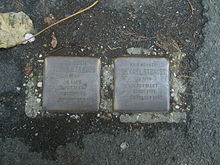
The town once had a Jewish community and a synagogue , which fell victim to the November pogroms in 1938 . The Jewish cemetery is still occupied today. In Neustadt, 41 stumbling blocks were laid by the artist Gunter Demnig , commemorating the Jewish victims of National Socialism. The first stumbling block on December 16, 2002 in front of the Kurfürst-Ruprecht-Gymnasium in Landwehrstrasse was dedicated to Karl Strauss , a former teacher of the school who was murdered in Auschwitz in 1942 . After the Second World War, Neustadt was initially the seat of the Rheinpfalz Gdö.R. before they moved to Speyer in 2011.
politics
City council
The city council of Neustadt an der Weinstraße consists of 44 honorary council members, who were elected in a personalized proportional representation in the local elections on May 26, 2019 , and the full-time mayor as chairman. Dirk Herber (CDU), Michael Landgraf and Werner Schreiner (both SPD) are among the current city councilors .
Because of the special features of the Rhineland-Palatinate electoral system in local elections (personalized proportional representation), the percentages given are shown as weighted results that only represent the voting behavior in arithmetic.
The parties and voter groups achieved the following results:
| Parties and groups of voters | % 2019 |
Seats 2019 |
% 2014 |
Seats 2014 |
|---|---|---|---|---|
| FWG | 31.2 | 14th | 18.4 | 8th |
| CDU | 25.2 | 11 | 36.4 | 16 |
| GREEN | 17.6 | 8th | 13.0 | 6th |
| SPD | 16.0 | 7th | 23.7 | 10 |
| FDP | 6.7 | 3 | 5.0 | 2 |
| THE LEFT. | 3.2 | 1 | 3.4 | 2 |
| total | 100.0 | 44 | 100.0 | 44 |
| Voter turnout in% | 62.3 | 53.2 | ||
Lord Mayor and City Council
- Community and city leaders
| Term of office | Surname | Political party |
|---|---|---|
| 1933-1936 | Werner Lederle | NSDAP |
| 1936-1938 | Richard Imbt | NSDAP |
| 1938-1944 | Karl Ludwig Schlee | NSDAP |
| 1945-1946 | Johannes Seibert , acting | |
| 1946-1949 | Heinrich Saul | CDU |
| 1949-1965 | Edwin Hartmann | SPD |
| 1965-1981 | Wolfgang Brix | CDU |
| 1982-1992 | Dieter no worries | CDU |
| 1992-2001 | Horst Jürgen Weiler | SPD |
| 2002-2017 | Hans Georg Loeffler | CDU |
| 2018– | Marc Weigel | FWG |
The Lord Mayor is directly elected for eight years. Marc Weigel (FWG) has been in office since January 1, 2018. His predecessor was Hans Georg Löffler (CDU, 2002 to 2017).
The City Board consists of the mayor and three Assistant : Ingo Röthlingshöfer (Department II / CDU), Waltraud Blarr (Department III / Green), Bernhard Adams (Department IV / independent)
coat of arms
| Blazon : "In black a red armored, tongued and crowned golden lion." | |
| Justification of the coat of arms: The coat of arms shows a right-turned golden lion on a black background, which is armed and tongued in red and wears a red crown with three red crosses. It is the lion of the Electoral Palatinate , whose seat of government was Neustadt with Winzingen Castle . |
Town twinning

The city is a founding member of the “Arbeitsgemeinschaft Neustadt in Europa ”, an international city friendship, which in September 2008 had 36 members from six Central European countries.
Neustadt maintains various city partnerships:
| city | Country, region | since |
|---|---|---|
| Mâcon | France, Burgundy | 1956 |
| Lincoln | United Kingdom, Lincolnshire | 1970 |
| Wernigerode | Germany, Saxony-Anhalt | 1989 |
| Manchester | United States, New Hampshire | 1992 |
| Quanzhou | People's Republic of China | 1995 |
| Mersin , district of Yenişehir | Turkey | 1998 |
| Genuine Susteren | Netherlands | 2019 |
Finances
Until 2004, Neustadt an der Weinstrasse was the only independent city in Rhineland-Palatinate that had been able to balance its budget since 1993 and at the same time reduce the mountain of municipal debt by over a third - around 37 million euros - between 1989 and 1999.
The indebtedness of the urban district Neustadt an der Weinstrasse had already reached its peak in the mid-1980s with a per capita debt of around 2,297 euros - at the prices at the time - with a population of around 50,000. In mid-1999, the per capita debt was around 1,173 euros.
Neustadt an der Weinstrasse received the "Verwaltungsmanagement Award 97" for intelligent savings concepts from the Institute for International Research and the magazine Die innovative Verwaltung in 1997 for this achievement .
Culture
Wall painting by Werner Holz
Buildings, monuments and memorials
- Cultural monuments
In Neustadt an der Weinstrasse there are numerous monument zones, including the historic old town , Hambach Castle , Wolfsburg , Winzingen Castle including Haardter Castle , Branchweilerhof , the Jewish cemetery and Spangenberg Castle, located far away from the settlement area, above the Elmstein Valley .
There are also numerous individual monuments; These include the collegiate church from the 14th century, the former University of Casimirianum and the Steinhäuser Hof within the old town .
The Sacred Heart Monastery is located on the Hambacher Höhe on Haardtrand . The Haidmühle is located in the east of the city on the Speyerbach . There is also the former Walter Engelmann bath .
The suburbs have other listed objects, such as Mußbach with the old Johanneskirche , the Herrenhof, the White House and the Carl-Theodor-Hof or Gimmeldingen with the Nikolauskirche , the Alte Burg and the König-Ludwig-Pavillon .
- Other structures
The old town also offer the Elwetritschen fountain of Gernot Rumpf and a historic building murals by Werner wood . In Gimmeldingen there are the remains of a Mithras sanctuary .
On March 10, 2013, the Rhineland-Palatinate Justice Minister Jochen Hartloff and the Mayor of Neustadt Löffler opened the memorial for Nazi victims , which had been established in the former prison building of the former Turenne barracks by a support association founded in 2009. 80 years earlier, from March 10, 1933, the National Socialists ran an early concentration camp in the barracks for several months under the name of protective custody and labor camp. Around 500 men from more than 80 Palatinate communities who disliked the rulers because of their political or religious activities were imprisoned.
Museums and culture
There are the following museums in the city: the City Museum Villa Böhm , the Otto Dill Museum, the Palatinate Bible Museum, the "Grain Box" wine-growing museum in the Herrenhof , the Ludwig Fellner Wine Road Atelier in Königsbach and the Railway Museum . The Kuckucksbähnel , a museum train for day trippers, runs from April to October on Sundays and public holidays between Neustadt and Elmstein .
The following locations are available for cultural events: the Saalbau as a theater and concert hall, the restored Herrenhof Mußbach as a cultural center, the open-air stage in the park of Villa Böhm, the cabaret theater reblaus in the Katakombe theater, the theater in the bend in Neustadt-Hambach and the historical stone houses courtyard as home of the jazz club NW .
Regular events
In Neustadt the German Wine Queen has been elected and crowned as part of the German Wine Festival since 1949 . The highlight of the festival, which traditionally takes place at the end of September / beginning of October, is the largest wine growers' parade in Germany.
Other wine festivals take place regularly, mostly on weekends, from the almond blossom in March / April to October. The almond blossom festival in Gimmeldingen, the Eselshautfest in Mußbach and the Andergasser festival in Hambach are particularly well-known .
At the end of August, the German Wine Route Adventure Day takes place, during which the German Wine Route is also closed to motorized traffic in Neustadt; only cyclists and pedestrians are allowed to use it on this day.
nature
There are numerous natural monuments in the district of Neustadt an der Weinstrasse ; including two rock formations called "Amber"; one is on the Weinbiet and the other on the Hohen Loog.
Neustadt extends from the Rhine plain into the Palatinate Forest Nature Park , the largest contiguous forest area in Germany and part of the Palatinate Forest-Vosges du Nord biosphere reserve . In the Neustadt area there are a total of twelve nature reserves : Am Wolfsberg , Lochbusch-Königswiesen, Mußbacher Baggerweiher, Haardtrand – Am Häuselberg, Haardtrand – Berggewanne, Haardtrand – Am Wetterkreuz, Haardtrand – Im Erb, Haardtrand – Am Klausental, Haardtrand – Schloßberg, Haardtrand –Am Heidelberg, Haardtrand –Am Sonnenweg and Rehbachwiesen-Langwiesen.
societies
The city is the seat of the DRK Schwesternschaft Rheinpfalz-Saar , the Palatinate Forest Association and the United Wage Tax Aid . There are also the football clubs VfL Neustadt / Weinstrasse and SV 1920 Geinsheim as well as the SC Neustadt water polo club .
Others
Neustadt was the godfather of the U 26 submarine of the German Navy . Since 1978, the city sponsored a Lufthansa - Airbus , since 2000 an ICE of Deutsche Bahn. In March 2007 the sponsorship for a train of the S-Bahn RheinNeckar was taken over.
In 1985 Horst Stowasser proposed a new form of project anarchism in a book. This so-called “Project A” aimed to anchor libertarian projects in everyday life in a small town. From 1989 onwards, attempts were made in Neustadt to put the idea into practice, for example with a residential project in which the "AnArchiv" was to be housed.
Economy and Infrastructure
economy
|
Largest wine-growing communities in the growing area |
Rank among all Rhineland-Palatinate wine-growing communities according to vineyards |
Planted vineyards in 2017 (in ha ) |
Grape varieties | |
|---|---|---|---|---|
| white | Red | |||
| (in %) | ||||
| Palatinate | 23,652 | 65 | 35 | |
| Landau (Palatinate) | 1 | 2,067 | 66 | 34 |
| Neustadt (Weinstrasse) | 2 | 2,031 | 67 | 33 |
| Cheap home-Ingenheim | 4th | 843 | 62 | 38 |
| Bad Dürkheim | 6th | 819 | 68 | 32 |
| Kirrweiler | 14th | 589 | 67 | 33 |
| Edesheim | 17th | 505 | 61 | 39 |
| Deidesheim | 18th | 498 | 85 | 15th |
| Wachenheim (Weinstrasse) | 20th | 473 | 75 | 25th |
| Goecklingen | 22nd | 464 | 65 | 34 |
| Freinsheim | 25th | 437 | 61 | 39 |
|
Source: Leaflet Viticulture 2018. State Statistical Office Rhineland-Palatinate, Bad Ems, May 2018 |
||||
- location
In 2016, Neustadt an der Weinstrasse generated a gross domestic product (GDP) of € 1.564 billion within the city limits . In the same year, GDP per capita was € 29,456 (Rhineland-Palatinate: € 34,118, Germany € 38,180) and was thus below the regional and national average. The GDP per labor force is € 55,499. In 2016, around 28,200 people were employed in the city. The unemployment rate in December 2018 was 4.5% and thus slightly above the average for Rhineland-Palatinate of 4.1%.
- Viticulture
Viticulture and tourism are among the most important branches of the economy. Neustadt an der Weinstrasse is the largest wine-growing community in Germany with 1994 hectares of planted vineyards after Landau in der Pfalz (2053 hectares) (as of July 31, 2009). Hiking trails in the Palatinate Forest and bike trails through the Upper Rhine Plain begin in Neustadt.
- forestry
Neustadt is the seat of the central office of the forest administration of the state forests of Rhineland-Palatinate .
- Established businesses
Hornbach Holding AG and SIGMA Elektro GmbH have their headquarters in Neustadt . Other larger companies in the city are Team Rosberg (motorsport), Deutsche Telekom , Gesellschaft für Dienst im Alter (GDA) and Meininger Verlag .
- forecast
In the 2016 Future Atlas , the urban district of Neustadt an der Weinstrasse was ranked 105th out of 402 districts, municipal associations and urban districts in Germany, making it one of the places with "future opportunities".
traffic
Road traffic
Neustadt has two junctions with the A 65 . Assuming that the routes are free, you can reach Ludwigshafen am Rhein and Mannheim in about 30 minutes , Karlsruhe and Kaiserslautern in 40 minutes and Stuttgart in 90 minutes. It takes about 70 minutes to get to Frankfurt Airport and 90 minutes to Hahn Airport .
In April 2008, cell phone parking was introduced in the city . From July 2006 on, Neustadt took part in a practical test of the system in which all citizens could take part.
Rail transport
The Neustadter Hauptbahnhof is the largest railway hub in the south of Rhineland-Palatinate. It is located about halfway between Mannheim and Kaiserslautern on the Mannheim – Saarbrücken railway , which was built from 1847 to 1849 as the Palatinate Ludwig Railway , the lines towards Bad Dürkheim – Grünstadt and Landau (–Wissembourg) - Karlsruhe branch off here. Since 1996, ICE trains have been stopping twice a day at Neustadt main station en route from Frankfurt am Main via Mannheim and Kaiserslautern to Saarbrücken . In the past, the three EuroCity connections from Frankfurt to Paris also stopped in Neustadt; Since the opening of the high-speed line Paris – Eastern France (–South Germany) on June 10, 2007, the ICE 3, which has been in service since then, no longer do this . In 2003 Neustadt was connected to the RheinNeckar S-Bahn in the form of lines S1 and S2.
The DGEG railway museum , which housed the Neustadt depot, which was dissolved around 1960, is located in the historic locomotive shed at the station . From 1912 to 1955 Neustadt was the starting point of the Palatinate Oberland Railway , which ran via Edenkoben to Landau in the Palatinate , and from 1908 to 1956 the end point of a narrow-gauge railway that began in Speyer and ended at the local train station east of the main train station.
tourism
The cabbage and beet cycle path and the German Wine Road cycle path run through Neustadt, both of which lead from Bockenheim to Schweigen-Rechtenbach and the Palatia cycle path from Lambrecht to Speyer .
Several hiking trails lead across the Neustadt area, including the Pfälzer Weinsteig trail and through the far west of the district the Saar-Rhein-Main long-distance hiking trail marked with a yellow bar .
There is also a hiking trail that is marked with a green and yellow cross and that leads from Bexbach to Ludwigshafen am Rhein and a route marked with a white and green bar that runs from the Obere Eselsmühle in Enkenbach-Alsenborn to Maikammer . Another is marked with a white-red bar and establishes the connection with Kaiserslautern and Speyer . One of these, marked with a green and yellow cross , leads from Bexbach to Ludwigshafen am Rhein. Two routes, marked with a red bar, lead through the urban area; one runs through the city center from Neuleiningen to Siebeldingen and a second through the forest area from Lambertskreuz to Breitenstein . The hiking trail, which is marked with a blue-red bar , runs from Kirchheimbolanden to Pirmasens and one that is marked with a white-blue bar leads from Battenberg to Wörth am Rhein . The district of Gimmeldingen is the eastern end of a path that is marked in red and white bars and which begins at the Rotsteig forester's house .
In addition, with the Hellerplatzhaus , the Hohe-Loog-Haus , the Klausentalhütte and the PWV-Hütte Lachen-Speyerdorf there are several huts of the Palatinate Forest Association in the city area . There is also a local section of the German Alpine Club that operates the Neustadter Hütte clubhouse within the city and the Fitz Rocks climbing hall in Landau .
Public facilities
The city is the seat of the Structure and Approval Directorate South (SGD South) . It was founded in 2000 and replaced the district government of Rheinhessen-Pfalz . In contrast to this, the SGD Süd, as the middle administrative authority, no longer has regional, but functional responsibilities, some of which extend to the entire federal state.
The Rhineland-Palatinate Finance Court is also located in Neustadt an der Weinstrasse . The administrative and district courts are also located in the court complex . Other authorities are also based. These include the General Customs Directorate - Directorate IV - Consumption Tax and Transport Tax Law and Audit Service , which emerged as a nationally competent specialist department as part of the restructuring of the Federal Customs Administration on January 1, 2016 from the previous Federal Finance Directorate Southwest with regional responsibility. In 1974 the service center for rural areas Rheinpfalz (DLR) moved from the city center to the eastern edge of the district of Mußbach. Until 2004 it was known as the “State Teaching and Research Institute for Agriculture, Viticulture and Horticulture” and then “Agricultural Information Rhineland-Palatinate” .
education
In Neustadt there are the following primary schools : Eichendorff-Schule, Ostschule, Heinz-Sielmann-Schule, Hans-Geiger-Schule and the primary school in Schöntal are in the core city, in the districts the Dr.-Albert-Finck-Schule in Hambach, the Brothers Grimm School in Diedesfeld, the Michael Ende School in Haardt, the School at the Storchennest in Geinsheim, the August Becker School in Lachen-Speyerdorf and one elementary school each in Mußbach and Gimmeldingen. The Schubert School is a special needs school with a special focus on learning.
The city also has the following secondary schools: The orientation level of Realschule plus in the Böbig school center includes, as a special case in Rhineland-Palatinate, school years 5 to 7. The orientation level of Realschule plus Maikammer-Hambach as an integrative all-day school is at home in the Hambach district . The Käthe-Kollwitz-Gymnasium , the Kurfürst-Ruprecht-Gymnasium , the Leibniz-Gymnasium and the vocational high school of the Neustadt vocational school are distributed in the core city.
There is also the Free Goetheschule as a Waldorf school and the Neustadt International School , which is the only such school in Rhineland-Palatinate. Adult education is covered by the adult education center .
The Neustadt wine campus is a joint institution of the universities of Ludwigshafen , Bingen and Kaiserslautern for studying oenology . The education center for professions in the health sector at the Hetzelstift hospital enables training and further education in the medical professions.
media
Local print media are the daily newspaper Die Rheinpfalz as well as the weekly Neustadter Nachrichten and the Stadtanzeiger . Likewise, chili - the magazine in Neustadt his publishing house seat.
The public television broadcaster Offener Kanal Weinstrasse can be received in the cable network and broadcasts from a studio in Neustadt. On May 31, 2008, the radio station Antenne Pfalz started broadcasting in Neustadt.
Personalities
The building contractor Conrad Freytag , theologian and local researcher Alban Haas , the textile manufacturer Friedrich Helfferich , the banker and patron Friedrich Hetzel and the polar researcher Georg von Neumayer were named honorary citizens of the city .
Well-known personalities from Neustadt include Elector Friedrich II of the Palatinate, Cardinal Johannes von Geissel , the politician and banker Karl Helfferich , the poet Lina Staab , the football player Mario Basler , the comedian Bernhard Hoëcker , the Prime Minister of Rhineland-Palatinate, Malu Dreyer , as well as the physicist Hans Geiger , the inventor of the Geiger counter .
literature
- Pirmin Spiess: A short history of the city of Neustadt . DRW-Verlag, Leinfelden-Echterdingen 2009, ISBN 978-3-7650-8514-7 .
- Michael Huyer: Monument topography Federal Republic of Germany . Monuments in Rhineland-Palatinate 19 = City of Neustadt an der Weinstrasse . Wernersche Verlagsgesellschaft , Worms 2008:
- Part 1: core city . ISBN 978-3-88462-264-3
- Part 2: Diedesfeld, Duttweiler, Geinsheim, Gimmeldingen, Haardt, Hambach, Königsbach, Lachen-Speyerdorf, Mußbach districts . ISBN 978-3-88462-265-0
Web links
- Literature from and about Neustadt an der Weinstrasse in the catalog of the German National Library
- Literature about Neustadt an der Weinstrasse in the Rhineland-Palatinate state bibliography
- In this country: Mandelgasse in Neustadt / Weinstrasse. State show Rhineland-Palatinate, SWR television, July 15, 2014
Individual evidence
- ↑ State Statistical Office of Rhineland-Palatinate - population status 2019, districts, communities, association communities ( help on this ).
- ^ German Wine Route . In: NSZ Rheinfront . Ludwigshafen October 21, 1935. The article shows that the new addition to the name was propagated as early as 1935; for legal dedication cf. Name development section .
- ^ A b City administration Neustadt an der Weinstrasse: Neustadt in numbers. Retrieved April 25, 2012 .
- ^ Wilhelm Volkert (ed.): Handbook of Bavarian offices, communities and courts 1799–1980 . CH Beck'sche Verlagsbuchhandlung, Munich 1983, ISBN 3-406-09669-7 , p. 539 .
- ^ Heinrich Grimm: New contributions to the "fish literature" of the XV. to XVII. Century and through their printer and bookkeeper. In: Börsenblatt for the German book trade - Frankfurt edition. No. 89, November 5, 1968 (= Archive for the History of Books. Volume 62), pp. 2871–2887, here: pp. 2874 f.
- ^ Wilhelm Volkert, Richard Bauer: Handbook of the Bavarian offices, municipalities and courts 1799-1980 . Munich 1983, p. 90
- ^ Franz Maier: Biographical Organizational Handbook of the NSDAP and its divisions in the area of today's state of Rhineland-Palatinate. Publications of the commission of the state parliament for the history of Rhineland-Palatinate . Vol. 28. Hase & Koehler, Mainz 2007. ISBN 3-7758-1407-8 ; P. 14
- ↑ Gauleitung, early concentration camp and Gestapo office: Sources on the Nazi era in Neustadt and the surrounding area in the Speyer State Archives (2013)
- ^ Official Journal of the French High Command in Germany, No. 35 (1946), p. 292
- ^ Full text of the constitution of May 18, 1947
- ↑ Order No. 9 of September 8, 1945 on the organization of the administration of the Palatinate and Rheinhessen
- ↑ Official municipality directory (= State Statistical Office of Rhineland-Palatinate [Hrsg.]: Statistical volumes . Volume 407 ). Bad Ems February 2016, p. 173 (PDF; 2.8 MB).
- ↑ partly different, but precise information for the 20th century on the website of the city administration
- ↑ Numbers, data, facts. Retrieved July 8, 2019 .
- ^ District- free city of Neustadt an der Weinstrasse Religion , 2011 census
- ↑ Municipal statistics of the district-free city of Neustadt an der Weinstrasse , accessed on January 27, 2020.
- ↑ Stumbling blocks. (No longer available online.) Stadt Neustadt, archived from the original on September 10, 2012 ; Retrieved September 12, 2012 .
- ↑ Explanation by the Land Returning Officer on weighted results.
- ^ Result of the election at the regional returning officer Rhineland-Palatinate
- ↑ Werner Holz (1948–1991): "Fantastic Allegory of Neustadt ad Weinstrasse"
- ↑ The "beginning" of our journey. Friends of the “Memorial for Nazi Victims in Neustadt”, accessed on March 14, 2013 .
- ↑ Heike Klein: When the chase machinery started . In: The Rhine Palatinate . Ludwigshafen March 6, 2013.
- ↑ Current results - VGR dL. Retrieved January 7, 2019 .
- ^ Federal State of Rhineland-Palatinate. Federal Employment Agency, accessed on January 7, 2019 .
- ↑ Future Atlas 2016. (No longer available online.) Archived from the original on October 2, 2017 ; accessed on March 23, 2018 .
- ↑ Federal platform for mobile phone parking.
- ↑ wine Campus - Campus wine Neustadt. Weincampus Neustadt, accessed on March 12, 2018 .
- ↑ educational center for health professions. Retrieved September 25, 2018 .



